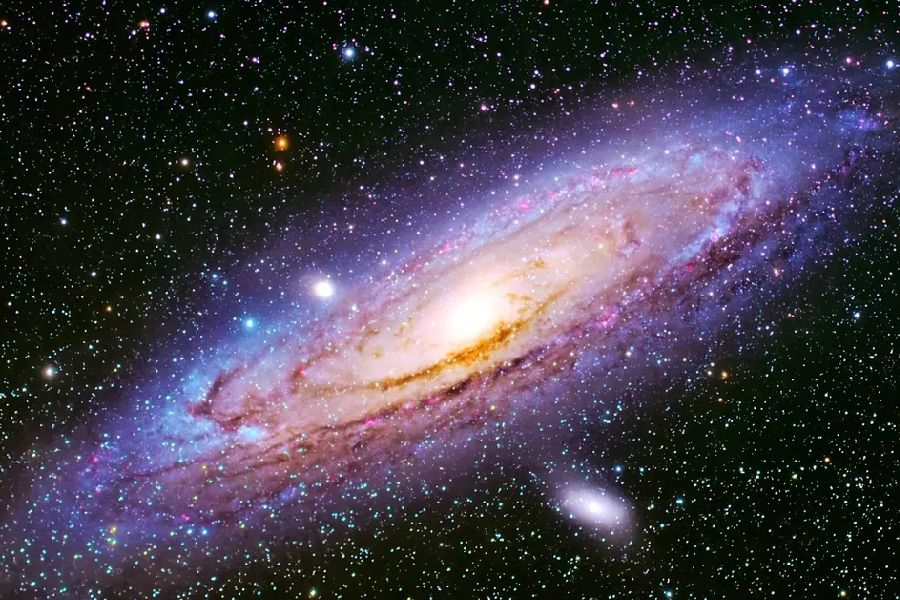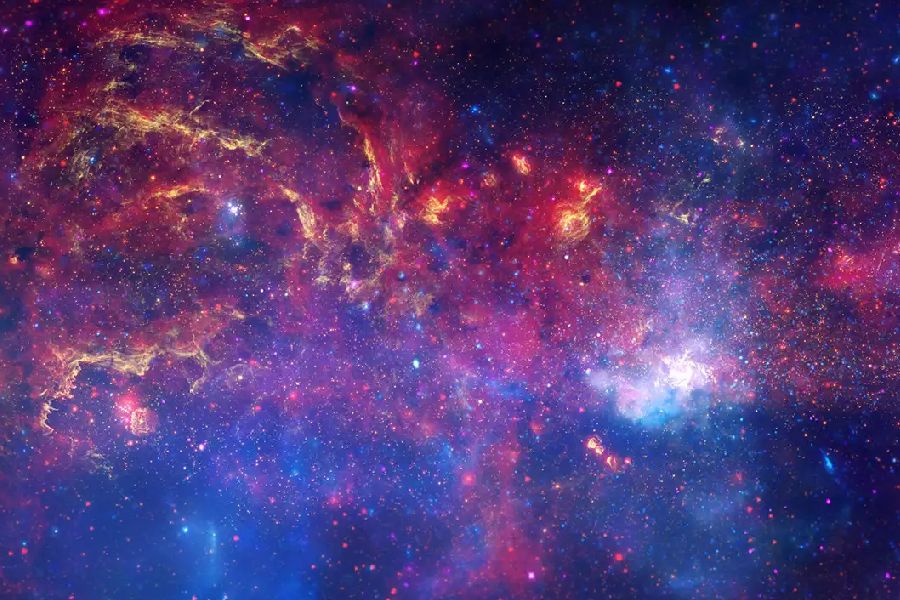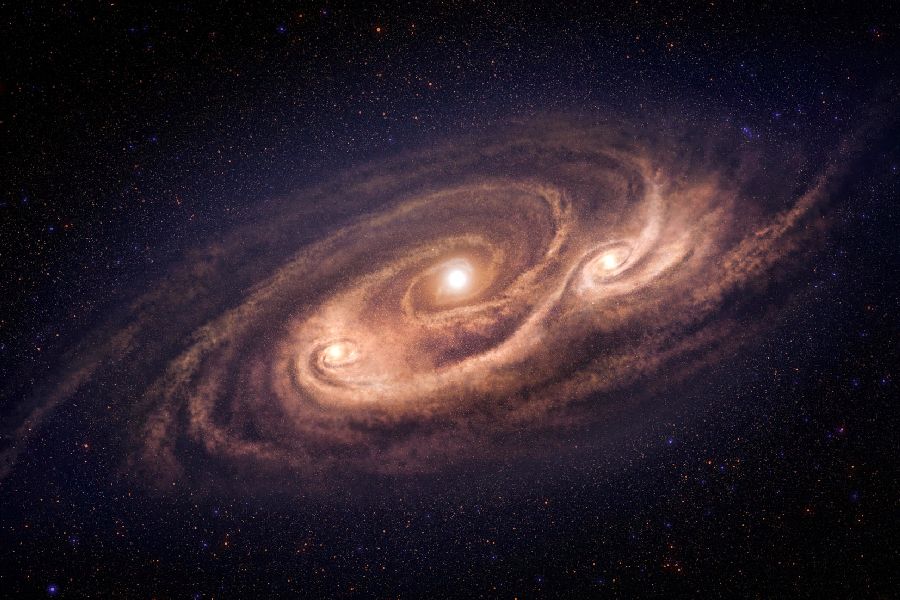Gazing up at the night sky, we behold a majestic tapestry of stars and celestial fireworks. But these myriad stars only constitute our tiny corner of the vast cosmos. Most reside within immense star cities known as galaxies, bound by gravity across unfathomable distances. The Milky Way we inhabit is but one example among billions. What are galaxies, and how vital are these grand structures to explain our universal origins?
In this exploration, we navigate through the mesmerizing diversity of galaxies, from the majestic spirals adorned with sweeping arms to the enigmatic ellipticals and the chaotic beauty of irregular galaxies.

What Are Galaxies?
Galaxies are immense systems of stars, gas, and dark matter bound together by gravity. They vary in shape – spirals, ellipticals, and irregular formations. Governed by gravity, galaxies cluster in the cosmic tapestry, and the Milky Way is just one of billions in the universe.
Galaxies hold billions or trillions of stars, shaping the cosmos and providing crucial insights into its origin and evolution. They are the fundamental building blocks of the universe, offering astronomers essential clues about the cosmic narrative.
Galaxies
Types of Galaxies
Galaxies, the celestial metropolises of the cosmos, reveal a mesmerizing array of forms. This exploration into galaxy classification unravels the cosmic architecture, spotlighting three main types: spirals, ellipticals, and irregulars.
Spirals
Spiral galaxies are generally flat or disk-shaped and boast majestic arms spiraling from a central nucleus. The majority of their stars, gas, and dust are concentrated in a flattened, rotating disk. This disk-like structure is a defining feature of spiral galaxies. The central bulge, containing older stars, often extends above and below the disk, while the spiral arms, where star formation is active, radiate outward flattened.
Exemplified by the iconic Andromeda Galaxy, these giants exhibit well-defined structures and vibrant star-forming regions within their graceful arms.
Ellipticals
Elliptical galaxies, in contrast to spiral galaxies, lack the distinctive spiral arms and flattened disk structure. Instead, they appear as rounded or elliptical in shape. Elliptical galaxies adopt elliptical or spherical shapes, emanating a serene, glowing ambiance dominated by aging stars. Ranging from colossal giants to modest companions in galactic clusters, Ellipticals showcase a diverse range of sizes.
Irregulars
Irregular galaxies, rebellious in their lack of symmetry, defy convention. Chaotic in appearance, they arise from gravitational interactions or cosmic mergers. They often exhibit chaotic and asymmetrical shapes, which are further divided into two subcategories: Irr I (Irr irregular) and Irr II (Irr compact).
The Magellanic Clouds near the Milky Way exemplify the charm of irregular galactic configurations.
How Do Galaxies Form
Galaxies merged from the gravitational collapse of primordial hydrogen and helium gas clouds in the early universe. As the gas collapsed under its own gravity, the first stars ignited, providing heat and light to the fledgling galaxies.
Over hundreds of millions of years, the ongoing accretion of gas has enabled primitive galaxies to grow in mass and compactness. Mergers between small galaxies also contributed to the buildup of larger galaxies.
Galactic lifecycle
As galaxies matured, distinct shapes emerged based on the angular momentum of their rotating matter. Galaxies undergo stages of evolution over billions of years, using up their gas supplies to form successive generations of stars.
These aging galaxies became more enriched in heavy elements dispersed through supernovae explosions. Their star formation rates slowly declined as less gas remained to birth new stars.
Interactions and Mergers
The continuing gravitational dance of galaxies drives mergers between neighbors. Smaller galaxies are directly consumed by their larger companions, contributing their stars to the combined system.
Even mergers between massive spiral galaxies transform their structure through bursts of new star formation and reshaping of their spiral arms. The Milky Way and Andromeda galaxies are currently on a collision course that will dramatically alter them 4 billion years from now.

The anatomy of galaxies
Stellar Bodies: The Luminous Matter
The brilliant pinpricks decorating our night sky showcase that galaxies are the foremost gatherings of stars. These cosmic metropolises contain anywhere from several billion up to a staggering one trillion stars, all gravitationally intertwined across the Gulf of lightyears.
Scorching blue giants glow fiercely amid their explosive early years while chilled red dwarfs smolder upon old age’s twilight at a fraction of our sun‘s brightness.
Between those extremes, steady yellow suns like our own fuse hydrogen for billions of years. The lives and deaths of successive stellar generations further enrich galaxies with heavier elements, seeding gas clouds in intricate nebulae where fresh stars ignite.
Interstellar Gas: Fuel for Star Formation
Garnishing galaxies’ glittering stars and colorful nebulae trace the trajectories of cosmic recycling between the realms of life and the afterlife. Stellar nurseries collapsing under gravity churn out fledgling stars amid billowing stellar winds and scorching ultraviolet radiation.
At the other end, dying stars festoon galaxies with ejected gases and the heavy elements forged in their nuclear furnaces. This interstellar medium gets incorporated into new suns and potential life-hosting planets.
The gas also ignites blazing celestial fireworks when shockwaves from supernovae slam into them. Connecting stars across epochs, elegant nebulae glow like galactic orchards blossoming between the spare winter trees.
Dark Matter: The Invisible Glue
For all the stellar spectacle, the brightest known matter constitutes but a fraction of galactic mass. Observations unveiled that galaxies spin far too rapidly for gravity from visible stars and gas to hold them together without flying apart.
Thus, scientists inferred galaxies are deeply submerged in massive dark matter haloes enveloping their luminous disks. Comprising over 80% of a galaxy’s total mass, this invisible substance functions as the gravitational glue cementing galactic structures against centrifugal forces that would otherwise prove ruinous.
While the particle nature of dark matter remains mysterious, unveiling its distribution and gravitational impact charts the unseen architecture upon which galaxies’ brilliant tapestries drape across the cosmos.
Clusters and Superclusters
On the grandest scales, galaxies dwell together in immense cosmic communities termed clusters and superclusters spanning millions of lightyears. These dazzling galactic gatherings offer profound glimpses into the architecture of the cosmic structure itself.
Galactic Clusters
Galactic clusters constitute the most massive organized structures in the universe, containing anywhere from a few dozen to many thousands of galaxies bound together by the gravity of invisible dark matter.
The Coma Cluster resides over 300 million light-years away and encompasses over 3,000 galaxies, swarming like glittering bees around an unseen hive.
Superclusters
Superclusters represent the largest coherent structures, containing dozens of interconnected galactic clusters pouring along multidirectional flows like rivers.
Our local group belongs to the Laniakea Supercluster, itself flowing toward the aptly named Great Attractor over 500 million lightyears distant, the core exerting gravitational sway over surrounding superclusters.

Galaxy Formation and Evolution
From Cosmic Seeds to Galactic Giants: The Lifecycle of Galaxies
Current models show galaxies coalescing from the gravitational collapse of gas clouds early in the universe’s history. As more material accretes, distinct galactic forms emerge as angular momentum flattens rotating discs.
Ongoing gas infall and mergers foster maturation from irregular blobs into majestic spirals and ellipticals over billions of years. Ultimately, galaxies achieve a type of homeostasis before declining through the loss of gas and stars. Our dynamic universe dictates that no galactic configuration endures eternally.
Unraveling the origins of galaxies through Cosmic Ages
Studying galaxies across successively greater distances unveils earlier eras in the cosmic timeline, enabling astronomers to effectively retrace galaxies’ evolutionary trajectory near the universe’s origin.
Comparing infant galaxies during their first billion years to present mature galaxies charts how rapid star formation and repeated mergers sculpted primordial blobs into the galaxies inhabiting the modern universe.
Each stage explored takes us closer to elucidating galaxies’ complete life stories from their beginnings as fledgling clusters of stars stirring in the early universe.
Galactic Mysteries and Unsolved Questions
Dark matter enigma
Astronomical observations unveiled that galaxies rotate far quicker than should be possible unless they contain considerably more mass than just stars and gas provide gravitationally. Thus, scientists proposed that galaxies are embedded within enormous haloes of invisible “dark matter,” constituting over 80% of galaxies’ total mass.
While dark matter functions as essential gravitational glue, its underlying composition remains unknown despite decades of theorizing. Dark matter does not emit, absorb, or reflect light, making it invisible to electromagnetic radiation. It doesn’t interact with regular matter through electromagnetic forces, which is why it’s challenging to detect directly.
Unraveling this astronomical mystery could profoundly reshape cosmic and elementary particle physics conceptions.
Unanswered questions fueling galactic research
From the earliest epochs of galaxy formation soon after the Big Bang to projections of our Milky Way’s collision with Andromeda 4 billion years ago, the galaxies represent epic stories of origins and destiny with numerous unresolved chapters.
Within the galaxies themselves, open questions abound involving supermassive black holes regulating star formation energetically to globular clusters containing some of the earliest stellar generations.
As technology progresses, unraveling galaxies’ outstanding mysteries further illuminates both cosmic history and physics frontiers.
Frequently Asked Questions
What’s inside a galaxy?
The main contents of a galaxy include stars, planets, gas and dust clouds, stellar remnants like white dwarfs and neutron stars, dark matter, and a supermassive black hole at its core. The abundances and distributions of these components depend on the galaxy type and its evolutionary stage.
Which galaxies are closest to us?
The galaxies closest to our own Milky Way galaxy are the Large Magellanic Cloud, the Small Magellanic Cloud, the Canis Major Dwarf Galaxy, and the Sagittarius Dwarf Spheroidal Galaxy. They are small satellite galaxies gravitationally bound to the Milky Way.
What is the role of supermassive black holes at the centers of galaxies?
Supermassive black holes at galactic centers, through the accretion of material, can emit tremendous amounts of radiation and relativistic jets. Supermassive black holes play a central role in shaping the structure and evolution of galaxies through their gravitational influence and the energy released during accretion processes.
This active galactic nucleus influences gas dynamics and regulates the rate of star formation in its host galaxy. Supermassive black holes may have played a key role in how galaxies evolved over time.
Which galaxy is Earth in?
Earth resides within the Milky Way galaxy – a large barred spiral galaxy containing over 200 billion stars. From our vantage point embedded within one of its minor spiral arms, we have a unique perspective to observe the majesty of our home galaxy.
The Milky Way offers a nearby template for understanding galactic ecosystems prevailing across the observable universe.
Conclusion
So, from what we’ve pointed out, what are galaxies? Galaxies are vast systems composed of stars, stellar remnants, interstellar gas, dust, dark matter, and other cosmic entities bound together by gravity. They come in various shapes and sizes, and there are billions of them throughout the observable universe.
From fledgling irregular blobs coalescing after the Big Bang to stately modern spirals rotating with majesty, galaxies unveil the origins of the cosmic structure itself.
